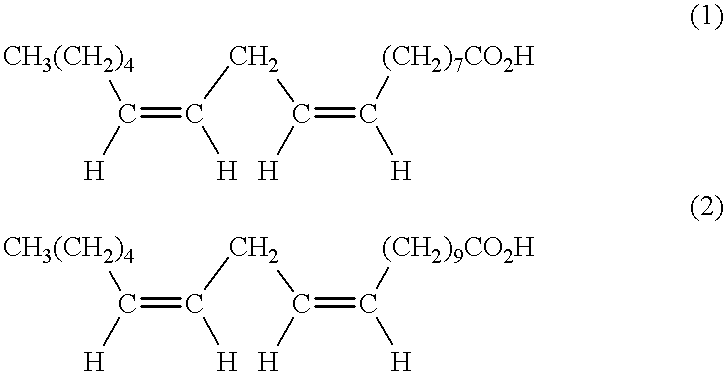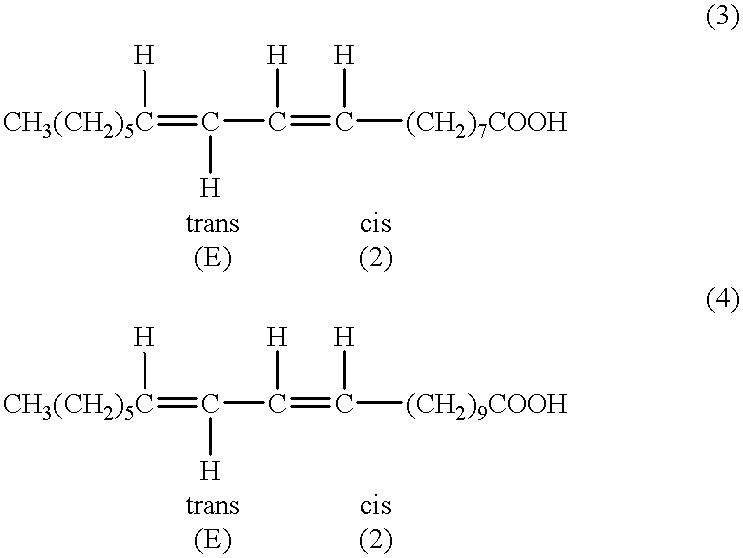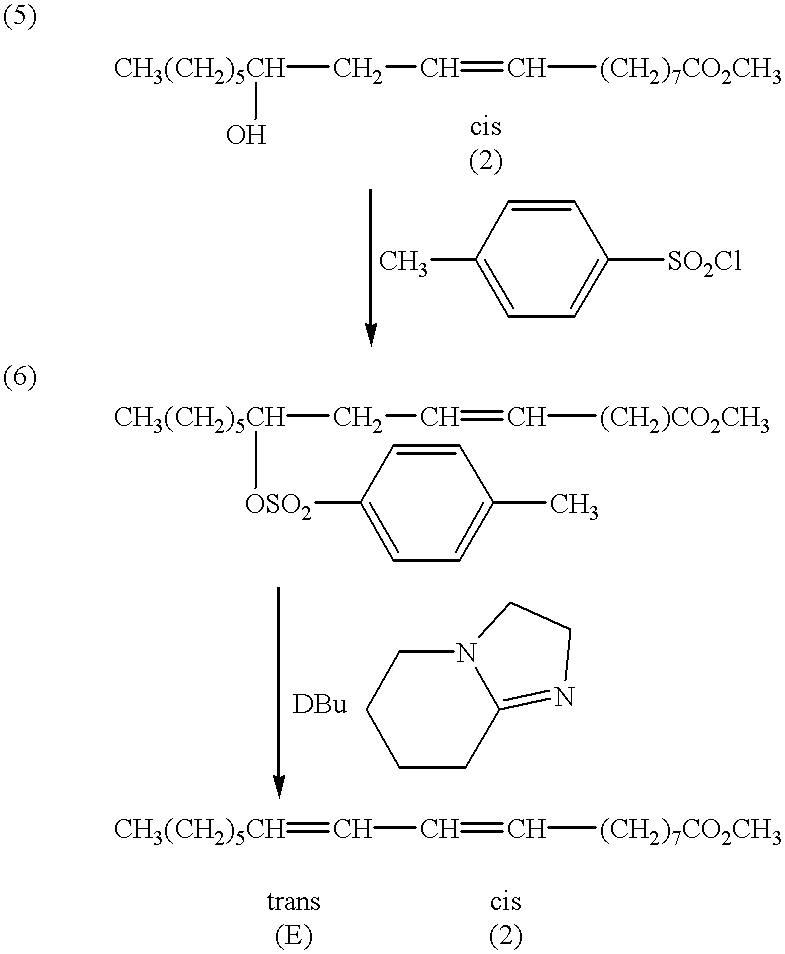Suppression of carcinoma using high purity conjugated fatty acid
a conjugated fatty acid and carcinoma technology, applied in the preparation of carboxylic compounds, fatty acid chemical modifications, biocide, etc., can solve the problem that the amount of fish oil needed to suppress tumors will exceed 10% in the di
- Summary
- Abstract
- Description
- Claims
- Application Information
AI Technical Summary
Problems solved by technology
Method used
Image
Examples
example ii
[0114] 400 g of lesquerella oil was admixed with 600 ml methanol and 3 ml of concentrated sulfuric acid. The mixture was refluxed for 5 hours. TLC (4 pet ether : 1 ethyl ether) showed starting oil disappeared. Distilled out about 200 ml of methanol. Cooled the mixture to room temperature, poured it into saturated NaCl solution (1L) and 1.5 g of NaOH in a separatory funnel. Partitioned it between the brine (basic) and pet ether. Gently shaked to prevent emulsion. Separated the aqueous into a flask, repeated the wash in basic brine once. Neutralized the aqueous solution with acetic acid to a pH of 6-7. Extracted the aqueous with pet ether twice and with ethyl ether twice. Combined organic layer was washed thoroughly with brine four times and water once. Checked the pH of washing carefully to make sure it was 6-7. Put into separatory funnel and took the organic layer into a round bottom flask. Distilled the solvent first at 1 atm then at reduced pressure to remove solvent and trace wat...
example iii
[0115] Methyl Lesquerolate from Example II in an amount of 242 g (.about.80%) FW 340 was admixed with NaOH-dried pyridine in an amount of 230 ml 4 eq. 0.71 mole. Cooled the mixture to .about.5.degree. C. Added 210 g of tosyl chloride. FW=190. (0.71 mole.times.1.5 eq.) Stirred the mixture at 10-20.degree. C. for four hours. TLC (25 EE : 75 PE) showed .about.40%-30% starting material remained. Put ice into the ice bath and immersed the reaction flask overnight. Morning temperature was 22-25.degree. C. Stirred at 10-20.degree. C. for 1 day. TLC checked reaction completed. Partitioned between ether and cold water. Extracted with ether. Washed with 10% sulfuric acid and water. The pH was 6-7. Dried over magnesium sulfate for 1 day. Filtered removed solvent at room temperature on rotevap.
[0116] The mixture was stirred at room temperature (20-30.degree. C., or 25-30.degree. C.) for 10 days. Then warmed at 60-70.degree. C. for 4 hours. TLC showed no tosylate. Partitioned between hexane and ...
example iv
[0117] 1500 g of lesquerella oil were admixed in 1300 methanol and 10 ml of concentrated sulfuric acid, and the mixture was stood at room temperature overnight. The mixture then was refluxed for 5 hours. The mixture was partitioned between NaCl saturated solution and hexane. The pH of the aqueous layer then was adjusted to 6-7 by adding HOAc. The organic layer was washed with saturated NaCl solution and water. The aqueous layer was extracted with ether. The ether layer was washed with brine and water. The combined organic layer was washed with water three times. The pH was .about.6-7. The organic layer was distilled at 1 atm to remove solvents, then under reduced pressure to remove water and solvents. Distilled the residue under high vacuum. Found the material decomposed during the distillation. The last drop contained decomposed compounds. Did not get pure lesquerella ester >93%, which indicated the methyl lesquerella ester decomposed in this experiment.
[0118] The residue in the di...
PUM
| Property | Measurement | Unit |
|---|---|---|
| temperature | aaaaa | aaaaa |
| pH | aaaaa | aaaaa |
| temperature | aaaaa | aaaaa |
Abstract
Description
Claims
Application Information
 Login to View More
Login to View More - R&D
- Intellectual Property
- Life Sciences
- Materials
- Tech Scout
- Unparalleled Data Quality
- Higher Quality Content
- 60% Fewer Hallucinations
Browse by: Latest US Patents, China's latest patents, Technical Efficacy Thesaurus, Application Domain, Technology Topic, Popular Technical Reports.
© 2025 PatSnap. All rights reserved.Legal|Privacy policy|Modern Slavery Act Transparency Statement|Sitemap|About US| Contact US: help@patsnap.com



